Eight Medieval Women for International Women’s Day
8 March 2021
Medieval blogger extraordinaire Lorna Webb is back with a special post for International Women’s Day.
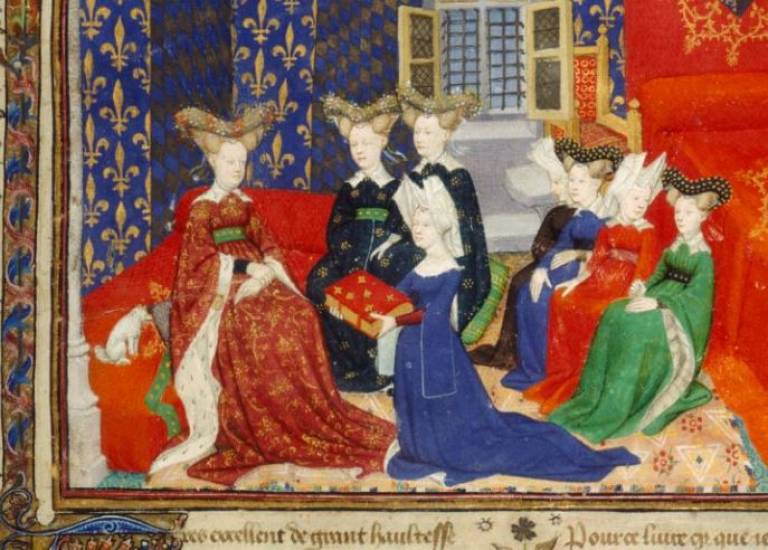
Introduction
So far when I have been writing about the medieval period I focus on written manuscripts. These manuscripts feature some of the most fantastic writing in both Old and Middle English and cover brilliant themes and theories, but one thing stands out about them; most are attributed to male writers. This is because the medieval world, much like the classical world, is dominated by male figures. In the medieval world kings are the rulers, the pope is the religious authority, and the more educated members of society – those who can read and write – are male. But there are exceptions.
Throughout the period spanning the early seventh to the late fifteenth century there are fantastic examples of women who were important enough to have a place in the centuries where women are almost forgotten. These women lived through moments of history, they are women of faith, queens and empresses, and mystics. So here are the lives of eight incredible medieval women for International Women’s Day.
Abbess Hilda of Whitby
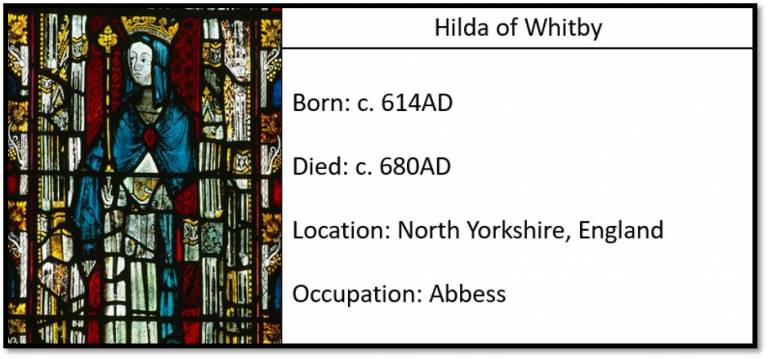
Starting in the early medieval period in the seventh century is Abbess Hilda of Whitby (Schoenbechler 1995). Little is known about her early life, but it is possible she was born into early medieval royalty, She is best known for founding the convent in Whitby, the sister organisation to that of the monks at Lindisfarne. She is also known for her part in the synod of Whitby (Bradley 2009). As the Abbess of the convent of Whitby she was invited to the religious gathering called to agree on the date of Easter in the kingdoms in England. After her death she was venerated as a saint. She is mentioned in Bede’s Ecclesiastical History of the English People (Historia ecclesiastica gentis Anglorum).
Æthelflæd
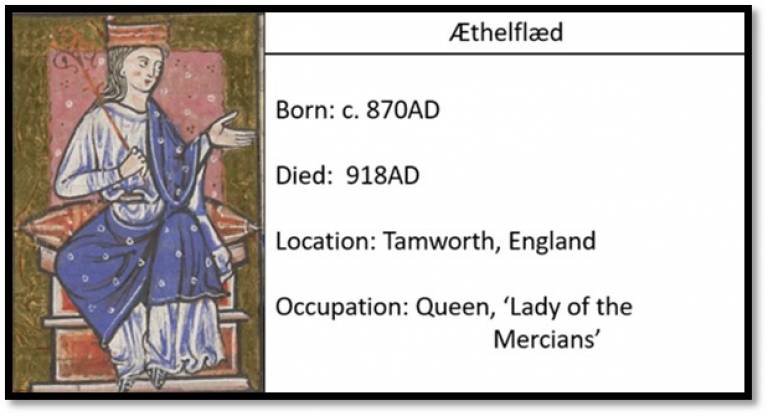
Also known as the Lady of the Mercians, Æthelflæd, the daughter of Alfred the Great (Abels 1998), is known as a leader who led her people against Viking raids and was pivotal in the unification of England in the late ninth century (Wood 2018). She is mentioned in the Anglo-Saxon Chronicle (Home 2015).
Æthelflæd married Æthelred, lord of the Mercians on the request of her father. When Æthelred died she became the sole ruler of Mercia. This is important as she would be the only Queen in a Kingdom of England to be an unchallenged ruler in her own right until the 16th century. Ordinary queens do not rule when Kings die, and this did not become the norm after Æthelflæd.
Hildegard of Bingham
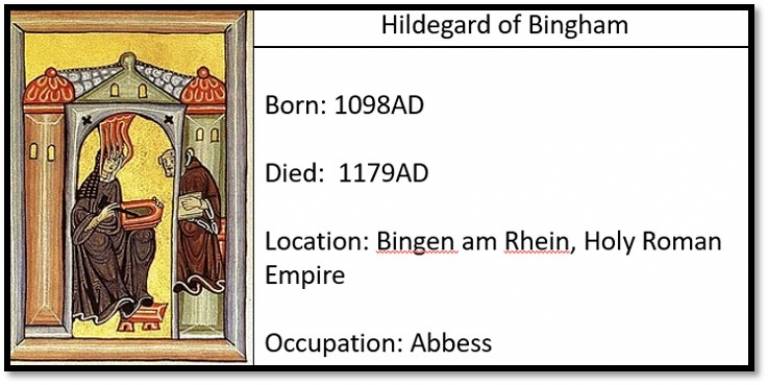
Hildegard has her place in this list because of her contributions to the education and the exploring of art and science. A nun in a Benedictine convent she was known for her visions and spiritualism (Maddocks 2001). During the 1100’s she wrote theology in three volumes;
- Scivias "Know the Ways", written 1142–1151
- Liber Vitae Meritorum "Book of Life's Merits" or "Book of the Rewards of Life", written 1158–1163
- Liber Divinorum Operum "Book of Divine Works", also known as De operatione Dei, "On God's Activity", written 1164–1172 or 1174
Hildegard is also credited for writing music. An example of this is the Ordo Virtutum which is a morality play (Potter: 1986) with 69 musical compositions within it. All the characters sing in plainchant and is a good example of medieval music. You can listen to it here, and find out more about early medieval music in my other blog post on Christmas Carols!
Matilda
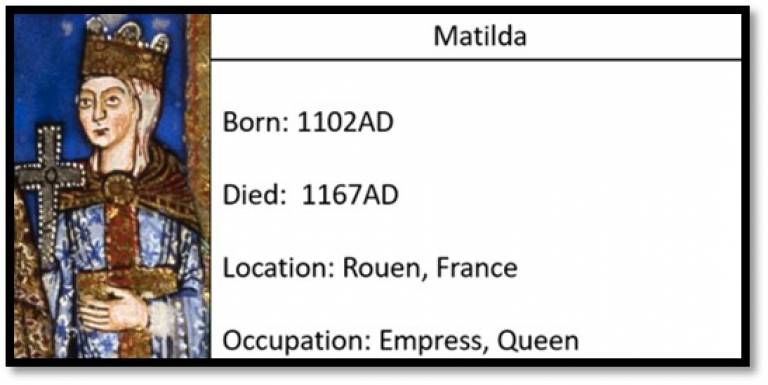
The eldest legitimate daughter of Henry I of England, Matilda is an important person in the history of the monarchy in England in the medieval period. She was married to the Holy Roman Emperor and therefore is referred to as Empress Matilda (Chibnall 2001). After his death she then remarried, and this marriage was to a man called Geoffrey of Anjou also known as Geoffrey Plantagenet. With Geoffrey she had three sons. After Henry I’s only legitimate son drowned in the disaster of the White Ship in 1120 she became the heir to the throne of England. This was highly contested and resulted in a civil war across England. Ultimately, the succession was resolved by a king taking her place. However, Matilda is an interesting character in history. The Plantagenet dynasty would rule England from Matilda’s son all the way to the fifteenth century and Richard III (Castor 2010).
Matilda is mentioned in many manuscripts and written accounts including the Anglo-Saxon Chronicle (Home 2015).
Eleanor of Aquitaine
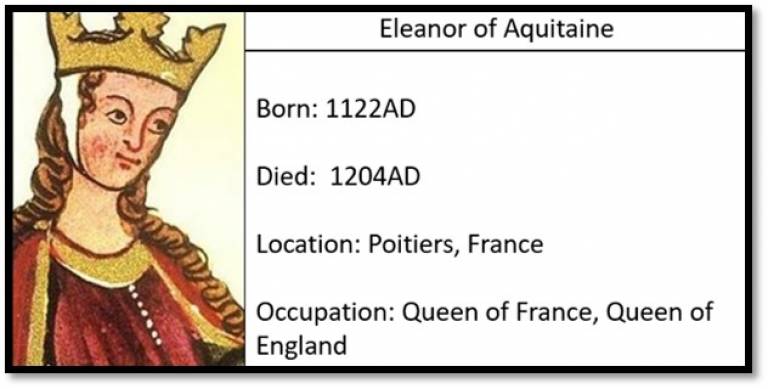
Born to the Duke of Aquitaine in the early 12th century, Eleanor was politically important figure as the province of Aquitaine was large and influential (Crawford 2012). She was originally married to the King of France, but this marriage was annulled.
Eleanor was then married to Henry II, Matilda’s eldest son and first of the Plantagenet kings. Family politics played a major part in Eleanor’s life (Weir 2008). She lead revolts and was frequently imprisoned by her husband and even her sons. She lived both in England and in France, ruled and controlled large areas of land in her own right. She died in 1204 and her tomb is a fantastic piece of medieval art, an effigy of her laid to rest beside her husband at Fontevraud Abbey.
Julian of Norwich
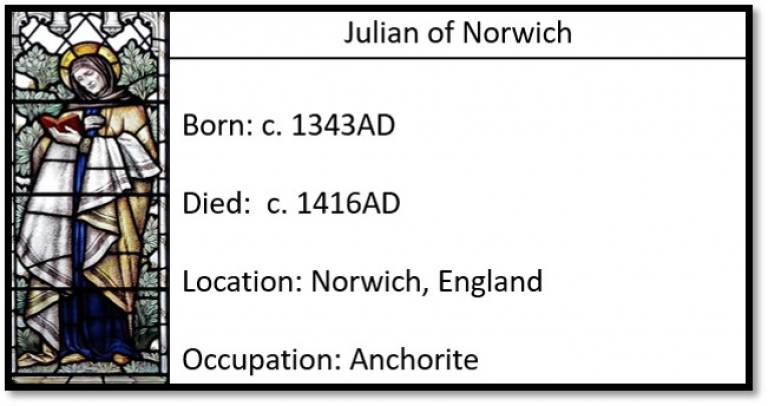
Out of all of the women on this list Julian has the humblest origins. Not much is known of her early life. Her given name is not even known, as Julian is the name of the church where she was an anchoress. It is possible that the Black Death, which hit the large prosperous town of Norwich particularly hard, led Julian to withdraw from secular society and become an anchoress (Ramirez 2016).
It was during this time Julian had her visions and subsequently wrote her book “Revelations of the Divine Love.” This book is important as it is written in Middle English not Latin and was probably a personal reflection, a woman expressing her own thoughts and feelings in a time where they are often lost.
Margery Kempe
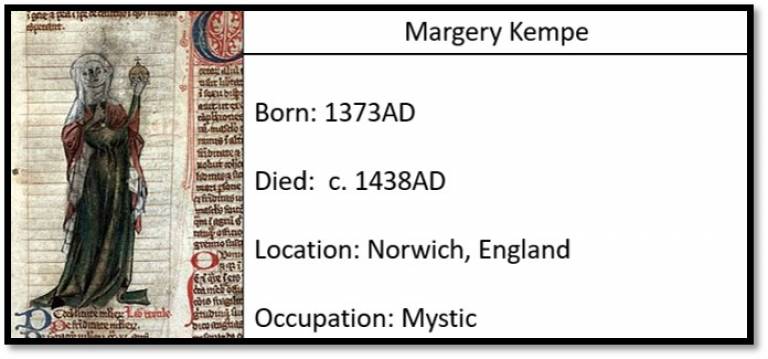
Margery Kempe lived in Norwich between 1373 to 1438, a contemporary of Julian of Norwich. She was a well-travelled woman, and had even visited the holy land as a pilgrim. She is known as a Christian mystic, and particularly for a book she wrote through dictation called “The Book of Margery Kempe”. Her book is considered by some to be the first autobiography in the English language. It explores her spiritualism and relationship with God (Mitchell 2005).
Elizabeth Paston
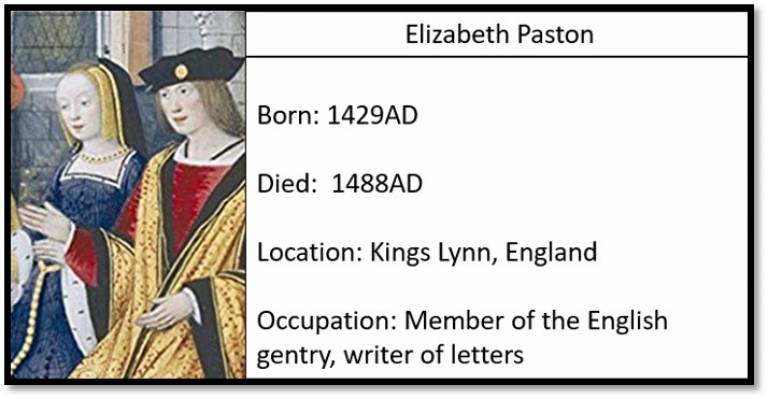
Born in 1429 in Norfolk, Elizabeth Paston was made famous through her letters which make up part of the Paston Letters (Watt 2004). She lived through the period which included the last of the Plantagenets and the Wars of the Roses. As a lady of the nobility, she had enough education to be able to read and write for herself. Her letters reflect the role of the woman in the home but also the knowledge and understanding of the political events entangling the men around her.
Conclusion
The ladies above represent a small group of individuals across the span of the medieval period. They are women that chroniclers saw fit to mention in their works. They are exceptional because of their high status in medieval society, be it marrying into royalty or being women of faith. This does not erase the plight, struggles and achievements of many ordinary women whose deeds are not recorded. The study of history is continuously evolving, and the stories of women and their deeds are being updated and explored more as History become less male focused. I, for one, welcome this change. History should be inclusive. If the women in this list show anything it is that they too occupy the same space as men.
Further Reading
- Information on woman in medieval society: https://www.bl.uk/the-middle-ages/articles/women-in-medieval-society
- The British Library has a fantastic blog post on Æthelflæd: https://www.bl.uk/people/aethelflaed
References
Abels, R, 1998 Alfred the Great: War, Kingship and Culture in Anglo-Saxon England. Harlow: Longman
Bede, 1996 The Ecclesiastical History of the English Church and People. Oxford: Oxford University Press
Bradley, I C, 1999 Celtic Christianity: making myths and chasing dreams. New York: St. Martins
Castor, H, 2010 She-Wolves: the Women Who Ruled England Before Elizabeth. London: Faber and Faber
Chibnall, M, 1991, The Empress Matilda: Queen Consort, Queen Mother and Lady of the English. London: Basil Blackwell
Crawford, K, 2012 Revisiting Monarchy: Women and the Prospects for Power. Journal of Women's History, 24(1), 160–171
Home, M, 2015 The Peterborough version of the Anglo-Saxon chronicle: rewriting post-conquest history. Woodbridge: The Boydell Press
Potter, R, 1986 The "Ordo Virtutum": Ancestor of the English Moralities? Comparative Drama, 20(3), 201-210.
Maddocks, F, 2001 Hildegard of Bingen: The Woman of Her Age. New York: Doubleday
Mitchell, M, 2005 The Book of Margery Kempe: Scholarship, Community, and Criticism. New York: Peter Lang
Schoenbechler, R, 1995 Anglo-Saxon Monastic Women. Magistra, 1(1), 139
Ramirez, J, 2016 Julian of Norwich: A very brief history. London: SPCK
Watt, D, (trans.) 2004 The Paston Women. Woodbridge: D.S. Brewer
Wood, M, 2018 Æthelflæd, Lady of the Mercians, 918-2018.
Weir, A, 2008 Eleanor of Aquitaine: By the Wrath of God, Queen of England. London: Vintage Books
Images:
Hilda of Whitby: Stained Glass Window in Christchurch College Oxford.
Æthelflæd: British Library Cotton MS Claudius B VI, f.14
Hildegard of Bingham: Miniatur aus dem Rupertsberger Codex des Liber Scivias.
Matilda: image from the Gospels of Henry the Lion
Eleanor of Aquitane: Weir, Alison. Eleanor of Aquitaine: A Life. Ballantine Books, 2001
Julian of Norwich: as part of the Bauchon Window, Norwich Cathedral; Norwich Cathedral
Margery Kemp: London, Wellcome Library, MS 544 (Miscellanea medica XVIII), early 14th century (France)
Elizabeth Paston: The Paston Letters: A Selection in Modern Spelling (Oxford World's Classics)
Cover Image: British Library Harley MS 4431 f.3r
 Close
Close

